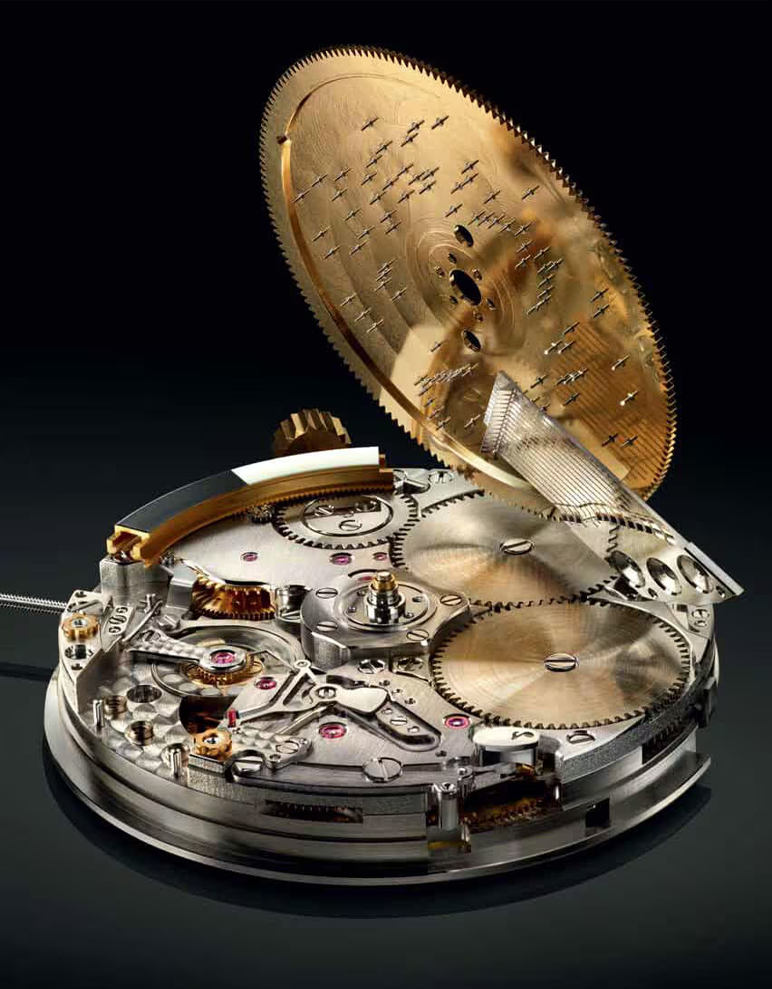Introduction of the magnetic strike governor
Breguet equips the Classique La Musicale with a magnetic strike governor. This patented system ensures a constant and regular tempo.
SILENT CONSTANT ROTATION
In common with all mechanical sonneries, the mechanism is powered by a spring barrel. If such a barrel were to be simply connected to a sonnerie, the effect of diminishing spring force would be a slowing in the pace of the musical sounding as the barrel is discharged. The common method for combating this phenomenon is to construct a regulator which is inserted in the train powering the sonnerie. However, a regulator which is constructed with spinning components emits sound of its own which would intrude on the melody of the sonnerie. To overcome this drawback, Breguet invented a silent regulator, using a technology never before brought to production mechanical wristwatches : magnets.
The rotating arms of the regulator are made of metal and are surrounded by static magnets in the exterior circumference of the regulator. As the metallic arms rotate in this magnetic environment, they produce an electrical field, which as it builds, is resisted by the magnetic field from the magnets. The faster the rotation, the greater the resistance and, correspondingly, the slower the rotation the lower the resistance. The result of all of this is a device that produces constant rotation, since both speeding up and slowing down are met with an alteration of the resistance to rotation opposite that of the change.
In other words, centrifugal force moves the silver disks of the regulator outward and more directly under the magnets, tending to slow down the rotation. At a slower speed, the springs pull the disks inward, tending to allow rotation to speed up.


CONFINED MAGNETISM
Not only is this utterly new system silent, but it avoids a problem associated with traditional regulator designs. The ordinary method for achieving regulation with a mechanical sonnerie relies upon friction : rotating arms inside a cylinder press against cylinder walls to regulate the rotating speed. Contact between two components with this traditional construction not only produces a “whirring” noise, but wear as well (which only gets worse as the lubrication deteriorates). By avoiding such contact between spinning components and an interior wall, Breguet succeed in eliminating both noise and wear.
Breguet surrounded the regulator with an iron case so that the magnetic fields of the regulator remain confined inside the iron case, thus, protecting the remainder of the movement. Two further design decisions insure that the magnets of the regulator will not affect the running of the watch. First the escapement and spiral are fashioned out of silicium which is a non-magnetic material. Second, the architecture of the movement evolved in a way that placed the regulator far away from the balance and escapement of the watch.
Incorporating within a wristwatch mechanism a music-box mechanism as well as the governor, guaranteeing the constancy of the tempo, was already a challenge in itself. Nonetheless, the company watchmakers, who were not only concerned with overcoming the disadvantages of the classic friction-based strike-governor system, but also with enhancing its performance, achieved the feat of creating an innovative system equipped with magnets and working on the principle of eddy currents (Foucault currents). This magnetic governor thereby does away with issues of wear, noise and the need for a large supply of energy, while ensuring increased precision.
In 2010, Breguet introduced the world's first magnetic governor for the strike in its 7800 “La Musicale” model. The brand demonstrates that instead of trying to counter the effects of magnetism, the phenomenon could be harnessed to improve the operation of watch movements.